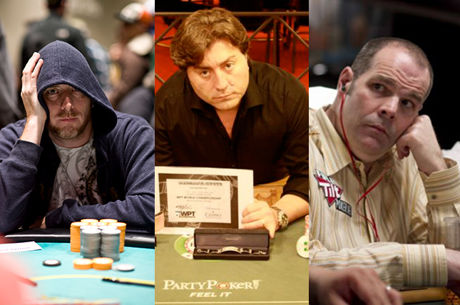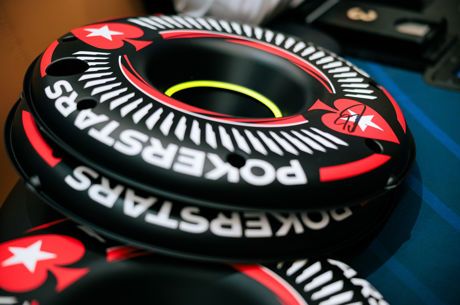Poker & Pop Culture: Cassius M. Coolidge's Dogs Playing Poker

When asked to name examples of poker turning up in popular culture, a famous painting of a group of dogs playing poker likely springs to mind as a first choice for many �� even before W.C. Fields peering out from under the brim of his stovepipe hat over a poker hand or the chorus of "The Gambler" by Kenny Rogers.
Everyone knows it, that absurd gathering of different breeds smoking cigars, drinking whiskey and beer, and playing cards as though they were human. You don't even have to play poker to be familiar with the poker-playing dogs, regarded by some as the epitome of kitsch or lowbrow culture, by others as an effective, insightful commentary on the middle and upper classes.
Even so, many don't know about the origins of "Dogs Playing Poker" �� nor that there wasn't just a single painting, but several of them. Let's delve a bit into these images of poker that may well rank among the most familiar depictions of the game ever produced by mainstream popular culture.
Calendars, Card-Playing Canines, and "Cash"
Cassius Marcellus Coolidge is the artist responsible for the iconic paintings. Born in 1844 in upstate New York, Coolidge had already pursued multiple careers before creating the paintings for which he'd achieve his greatest fame, including turns as a school superintendent, a town clerk, and a small business owner. He'd even helped open and run a bank, a fitting occupation for someone who during childhood picked up the nickname "Cash."
The moniker fit well with Coolidge's entrepreneurial streak, too, as he was involved throughout his life in various money-making schemes and ideas. Probably his best-known achievement not having to do with painting dogs was coming up with the idea for "comic foregrounds" �� that is, those life-sized portraits with the faces cut out for people to stick their heads through to create funny photos.
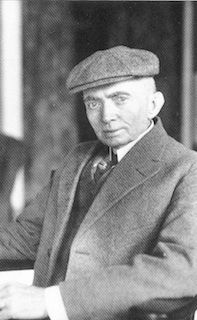
Meanwhile Coolidge additionally worked as a journalist, writing a column for which he drew his own illustrations. He even penned a comic opera about a mosquito infestation in New Jersey titled King Gallinipper, once performed in the 1880s.
Along the way Coolidge always painted and drew, successfully selling a number of his illustrations to various outlets. As early as the 1870s he had begun painting dogs, with a cigar company purchasing some to include on their boxes. A few of these early depictions of dogs featured them adopting human poses, including one in particular from 1894 showing four St. Bernards playing poker. That one �� simply titled "Poker Game" �� would prove a precursor of more such paintings to come.
It was in 1903 �� when Coolidge was nearly 60 �� that he was hired by the Brown & Bigelow advertising firm to create a series of oil paintings to be used in calendars advertising cigars. Though only a fledgling company at the time, Brown & Bigelow would go on to publish many of America's most popular calendars in the 20th century, ranging from Norman Rockwell's famous Boy Scout calendars to those featuring Gil Elvgren's popular "pin-up" girls.
Coolidge ultimately produced 16 different paintings for Brown & Bigelow, all of which featured dogs engaged in various human activities. The calendars were a big hit, and in fact Coolidge was able eventually to sell the original paintings for prices ranging from $2,000 to $10,000.
Barking and Bluffing
Of the 16 paintings for the calendars, seven of them featured the dogs doing other non-poker things such as attending a baseball game, conducting a trial, playing pool, struggling over a broken down Model T, and celebrating New Year's Eve. The other nine all show them playing poker, and when considered as a sequence convey many different scenarios and settings commonly associated with our favorite card game.
The most famous of the nine is "A Friend in Need", the one featuring seven dogs closely gathered around a starkly-lit table studying their cards �� and each other.
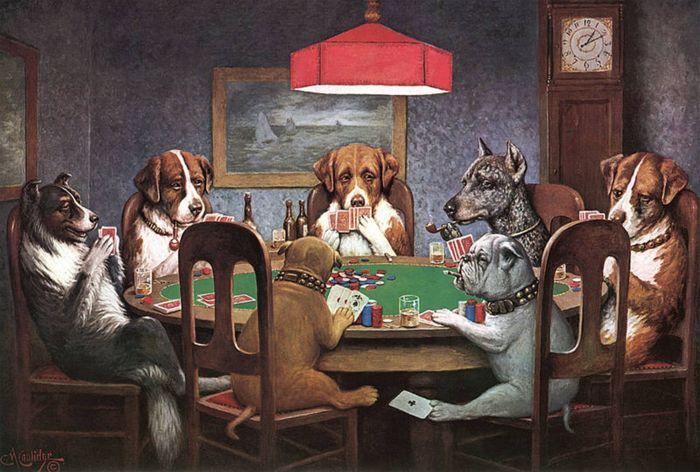
Look closely and it's clear the game isn't on the up-and-up. The cigar-chomping gray bulldog in the foreground is holding the ace of clubs in his extended paw under the table, apparently passing it to the tan-haired one on his left who looks to be holding the other three aces. As the smallest dogs at the game, perhaps these two struck up an alliance for dealing with their larger opponents.
Two of the paintings, "A Bold Bluff" and "Waterloo," tell a sequential story in a manner that recalls the works of the great 18th-century artist William Hogarth.
In the first ("A Bold Bluff"), a St. Bernard appears in the foreground on the left, a large tower of chips which he has presumably just pushed forward sitting in the center of the table before him. The other dogs look at him intently, but he gives away nothing behind the pair of spectacles resting on his snout.
Then in the second ("Waterloo"), his hand �� a modest pair of deuces �� has been revealed to the others. The St. Bernard grins as his paws rest on the large pile of chips he has just claimed, the other dogs registering various forms of surprise and dismay, having fallen victim to the bold bluff.
For some of the paintings, Coolidge moves the dogs' games to other locations. "His Station and Four Aces" shows them playing on a train, with the dogs wearing an assortment of hats and coats suitable for travel. A conductor has interrupted the game to inform an aghast-looking player the train as reached his stop. Bad timing �� he has four aces! Another painting, "Stranger in Camp," finds the dogs at a campsite, apparently in conflict as the chips and cards are all scattered about with two of the players locked in what looks to be a pre-fight staredown.
"Poker Sympathy" shows a poor boxer falling back in his chair, his beer spilled and his four aces sliding off the table in response to seeing his opponent's straight flush. "Post Mortem" shows the cards stacked on table with just three dogs seated around it, still drinking, smoking cigars, and ostensibly discussing the night's activities. "Pinched with Four Aces" takes us back to the home game, this time being broken up by four dogs in police uniforms.
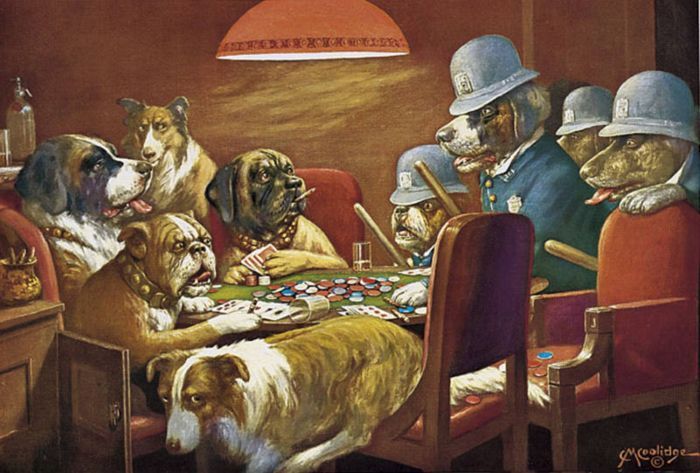
"Sitting Up with a Sick Friend" is the only one of the nine Brown & Bigelow paintings to feature female dogs, so designated by their fashionable hats. Given the scene, the title appears to describe the lie told by the men to the women regarding the true nature of their gathering �� a situation prefiguring the one in the 1912 film A Cure for Pokeritis. One of the female dogs has an umbrella raised as if to strike one of the players, as a guilt-confirming playing card falls from the table in the foreground.
Finally in 1910 came one last painting featuring yet another suspenseful scene from a private game where a big bet has been made and a table full of dogs (including one more female spectator) eye the bettor warily. The title of that one could refer both to the hand the bettor holds and his four similarly suspicious opponents �� "Looks Like Four of a Kind."
It's a Dog-Eat-Dog World
All of these paintings �� either collectively or singly �� get commonly referred to by the generic title "Dogs Playing Poker." Among the various ideas they convey, they certainly help document how by the turn of the 20th century poker had found its way from gaming dens, saloons, and steamboats into private homes. Poker had become a favored pastime enjoyed not just by outlaws and miscreants, but also by respectable "doctors" and "lawyers" (as the dogs seem to be).
It's worth noting as well how the world inhabited by Coolidge's dogs is decidedly male-dominated, once again reinforcing poker's "masculine" subculture. As such, it somehow seems appropriate that Coolidge chose dogs to anthropomorphize in his paintings.
In a 2002 New York Times article, Coolidge's daughter, Gertrude Marcella Coolidge, then 92, tells how she and her mother preferred cats to dogs, and wonders what the paintings would have been like had her father gone in a different direction.
"You can't imagine a cat playing poker," she ultimately decides. "It doesn't seem to do."
Was it Coolidge's purpose to satirize male behavior as somehow animal-like? Or was his target much broader, meant to incorporate the whole of the American middle and upper classes and their foibles?
In Poplorica: A Popular History of the Fads, Mavericks, Inventions, and Lore that Shaped Modern America, Martin J. Smith and Patrick J. Kiger speculate that Coolidge indeed intended the series as a satire. To support their argument they point out how "A Friend in Need" uncannily echoes Georges La Tour's 17th-century painting "The Cheat with the Ace of Diamonds," a painting clearly intended to "expose the moral turpitude of the upper classes."
Does such an allusion indicate Coolidge was using a commercial medium to make a similar pronouncement about middle- or upper-class America? If he were, America doesn't seem to have minded very much.
Over the years the popular paintings have been widely reproduced in a variety of media, including as posters, figurines, needlepoint kits, clocks, coasters, and, most suitably, on the backs of playing cards, not to mention being frequently alluded to in countless other works of popular culture, including television shows, music, plays, films, and even video games.
At least a few among the upper class continue to like them as well. At an auction in 2005, a private collector from New York City purchased the originals of "A Bold Bluff" and "Waterloo" for a cool $590,400. Then last year the initial painting "Poker Game" sold in another auction for $658,000.
Talk about fetching a lot of bones.
From the forthcoming "Poker & Pop Culture: Telling the Story of America��s Favorite Card Game." Martin Harris teaches a course in "Poker in American Film and Culture" in the American Studies program at UNC-Charlotte.



